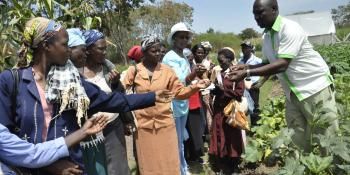Outscaling climate-smart agriculture in East Africa

In order to scale up climate-smart agriculture, we need to share lessons with stakeholders through open forums such as knowledge days.
In May 2015, the CGIAR Research Program on Climate Change, Agriculture and Food Security (CCAFS) East Africa researchers joined over 50 other participants from CGIAR centres, NGOs, private sector and the Kenyan government to discuss and share pathways for outscaling climate-smart agriculture (CSA). The meeting was organised by the International Centre for Tropical Agriculture (CIAT).
Participants learnt about the climate-smart villages (CSV) model being implemented in East Africa, West Africa, Latin America, Southeast Asia and South Asia. Through the CSV model, CCAFS and partners are focusing on improving local knowledge of climate risks and variability in seasonal rainfall, dry spells, and diseases and pests to inform farming decisions. The goal is to respond to climate variability, improve food security and enhance household incomes. This is achieved through the participatory testing of resilient technologies, training to build the knowledge and capacity to change local practices and improve planning for adaptation to changing farming conditions. Through participatory action research approaches, we are testing a portfolio of CSA interventions, allowing farming households to make progressive changes to their crops and cropping patterns as well as introducing new resilient livestock breeds.
During the meeting, we shared emerging lessons from the Nyando CSVs in Western Kenya where a shift in farming techniques has reduced the number of households eating one or no meals each day. Read these findings: Climate-smart villages and the hope of food secure households
Read the original blog on the CSA knowledge sharing day on the CIAT website.
Post by Vivian Atakos, Communications Specialist CCAFS East Africa.
Original blog on the CIAT website was written by Leigh Winowiecki (soil scientist) and Caroline Mwongera (post doctoral scientist).



